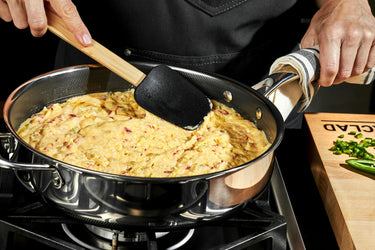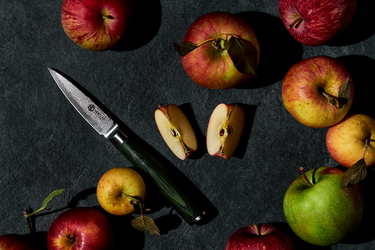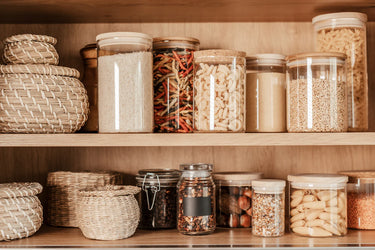Sauté Pan vs. Frying Pan: A Pros & Cons Guide

Whether you’re an avid fan of all things food, a lover of cookware, or both, you know a powerful pan is a kitchen essential. However, there isn't just one type of pan you need when creating delicious cuisine. While both frying and sauté pans can get the job done, some recipes benefit from one over the other.
Understanding the differences, advantages, and disadvantages of these pans is vital to mastering the kitchen one recipe at a time.
At HexClad, we use high-quality, patented technologies to produce cookware any chef will love. That’s why our frying and sauté pans can handle any messy challenge. Even if both of these pans can easily handle a variety of cooking duties, sometimes it's hard to determine which one is the best option for tonight’s meal.
If you are having trouble figuring out if a frying pan or sauté pan is best for you, we’ve got you covered. Today, we’re going over the advantages and disadvantages of a frying pan and a sauté pan, so you can get cooking.
What Is a Sauté Pan?
A sauté pan might sound fancy, but it's not as complex as it seems. A sauté pan is used for sautéing or frying food in various oils and fats. It is usually wide with steeper sides, so it can cook the food inside without the risk of it sliding off the pan and creating a mess.
Types of Sauté Pans
If you want to experiment with different sauté pans in your home kitchen, there are several types to choose from. Some of your options for sauté pans include:
-
Stainless Steel Sauté Pans are one of the more popular options due to their versatility and durability. Their high quality usually lasts for a while and can handle heavy quantities of food or sauces.
-
Non-Stick Sauté Pans are another useful option, as they prevent food or sauce from sticking to the pan, making them ideal for eggs and omelettes. However, one of the disadvantages of this sauté pan is that they tend to have a short lifespan. The non-stick coating is at risk of being scratched off or ruined by the utensils you use.
-
Cast-Iron Sauté Pans are not only easy to clean but are an ideal heat conductor for your dish. This pan is a perfect conductor of heat due to its thermal density, resulting in more prolonged and even heating. Another benefit of cast-iron sauté pans is that they are long-lasting. However cleaning them can be a chore, as scrubbing and soap will remove their seasoning, and they are prone to rusting if not well dried.
-
Hybrid Sauté Pans using HexClad’s patented cookware design technology combine the durability of stainless steel, the ease of non-stick, and the even heat of cast iron in a metal that’s oven safe up to 500 degrees. Stick it in the dishwasher, and use it with metal utensils — the unmatched power of this pan gives you everything you need and more.
Things To Consider When Cooking With Sauté Pans
Even though sauté pans are versatile, some situations are more ideal than others. Sauté pans are best saved for cooking in shallow oils or fats.
Our favorite sauté pan meals? Curries, sauces, braised meats, and chilies. Just remember that even though a sauté pan’s steep sides can contain what's inside, excessively stirring can lead to spills.
Once you pick what you’re cooking, it’s time to turn up the heat. If you use direct heat in a sauté pan (aka, placing your pan on heat sources such as electric, gas, or induction), you have to stir the food so everything is heated evenly. This’ll cook your food more quickly than indirect heat, and there isn’t really a benefit to using indirect heat on a sauté pan.
What Is a Frying Pan?
A frying pan, sometimes known as a skillet, is a pan for frying and searing meat or vegetables. You can also use it for stir-frying and quick cooking. Like sauté pans, there are also different types of frying pans to choose from.
Types of Frying Pans
Aside from also the non-stick and stainless steel options frying pans share with sauté pans, there are other types to consider, such as cast-iron, hard-anodized, ceramic, and carbon steel. (Of course, we’re still partial to our best-in-class hybrid technology.)
-
Cast-Iron Sauté Frying Pans are ideal for broiling, searing, frying, and baking. Since this type of pan requires a bit more upkeep, seasoning your pan helps bring out the flavor of your dish. Another contributing factor is that it's also an ideal heat conductor.
-
Hard-Anodized Frying Pans are pans made of a hard-anodized aluminum base. Hard-Anodized means a process variation that uses higher voltage and lower temperature to produce a tougher, more durable cookware coating. This pan helps when searing, frying, and braising.
-
Ceramic Frying Pans are usually lightweight, unlike the previously mentioned pans. However, the material is susceptible to damage from extreme heat and metal utensils because it's ceramic. They also tend to have a shorter lifespan because of their coating.
-
Carbon Steel Pans are another lightweight option in comparison to other pans. Although they are a bit skinnier than most pans, they are not sensitive to high heat and are oven safe.
Hybrid Pans get you the best of both worlds. Thanks to a science-backed combination of materials, hybrid pans are perfect for sauteing, searing, browning, and frying. These pans are built to last, even with constant use for different cooking methods.
Things To Consider When Cooking With Frying Pans
Even though most frying pans have a non-stick feature, some don’t. If your frying pan isn't a non-stick version, you will have to apply cooking oil to make sure you can get your food off of your pan at the end of cooking.
Frying pans are kind of a jack-of-all-trades — as long as you don’t need a ton of space for a one-pan recipe, a frying pan can probably get the job done.
Advantages and Disadvantages of a Sauté Pan
So, now that you know the deal with sauté pans, how can they enhance your cooking experience? Here are some advantages and disadvantages of using a sauté pan.
Advantages of a Hybrid Saute Pan
- The design has steep sides to contain food or sauces, preventing spillage.
- Has a large, spacious surface area for fitting foods from large to small.
- Usually has a non-stick surface to prevent sauce or oil residue from the pan.
- It can also be used for deep-frying due to its depth.
Disadvantages
- It cannot be used if you’re tossing or flipping over food.
Advantages and Disadvantages of Using a Frying Pan
When using a frying pan, one of the primary advantages is that it brings out the flavor of the food, but there’s more to this utility player than meets the eye:
Advantages of a Hybrid Frying Pan
- It cooks food faster.
- It’s able to hold more food even though it's shallow.
- It’s ideal for searing, braising, or frying meat.
- Its design makes it easy to cook multiple ingredients at once.
- It’s easy to wash in the sink or dishwasher.
- It can be used with a lid to control evaporation.
- It can be used with metal utensils.
- It’s safe in the oven up to 500 degrees.
- It’s durable and can last for years.
Disadvantages
- Some are sensitive to higher temperatures — choose one designed for high heat.
- It is shallow, running the risk of spillage.
Final Thoughts
So, which is the best option: sauté or frying pan? It ultimately depends on what you are cooking. A frying pan is the perfect tool when you want to quickly cook salmon fillets, veggies, frittatas, or eggs. On the other hand, a sauté pan is ideal for high-heat searing, reducing, simmering, or poaching.
We hope that this guide helps you figure out which one is ideal for anything you conjure up in the kitchen!
Sources:
Are Nonstick Pans Safe? | Scientific American
Difference Between Fry Pan and Sauté Pan | Difference Between





